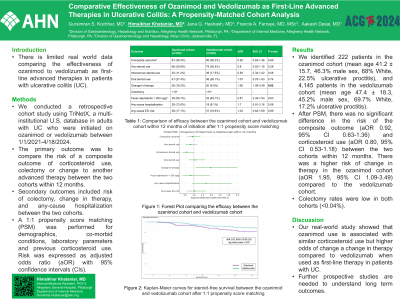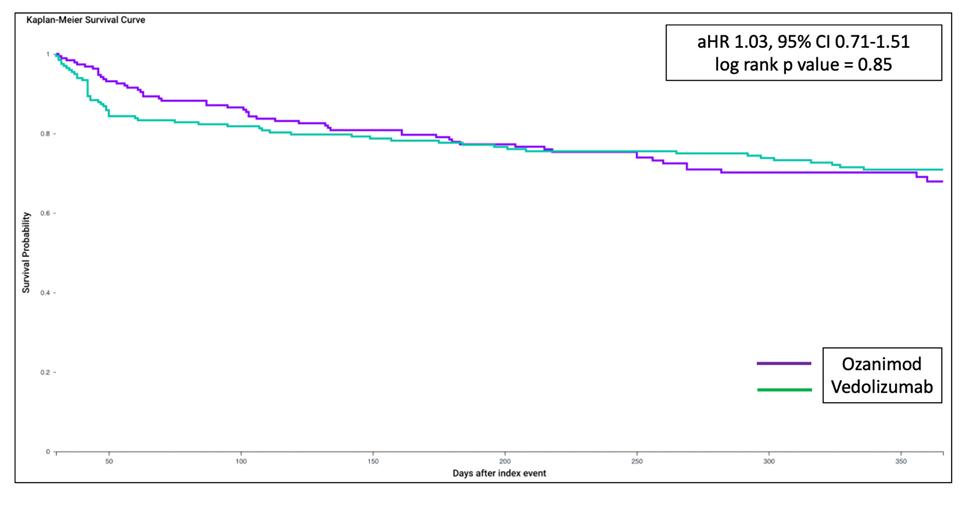Sunday Poster Session
Category: IBD
P0872 - Comparative Effectiveness of Ozanimod and Vedolizumab as First-Line Advanced Therapies in Ulcerative Colitis: A Propensity-Matched Cohort Analysis
Sunday, October 27, 2024
3:30 PM - 7:00 PM ET
Location: Exhibit Hall E

Has Audio

Himsikhar Khataniar, MD
Allegheny General Hospital
Pittsburgh, PA
Presenting Author(s)
Gursimran S. Kochhar, MD1, Himsikhar Khataniar, MD1, Jana G. Hashash, MD, MSc2, Francis A. Farraye, MD, MSc2, Aakash Desai, MD3
1Allegheny General Hospital, Pittsburgh, PA; 2Mayo Clinic, Jacksonville, FL; 3Mayo Clinic, Pittsburgh, PA
Introduction: There is limited real world data comparing the effectiveness of ozanimod to vedolizumab as first-line advanced therapies in patients with ulcerative colitis (UC).
Methods: We conducted a retrospective cohort study using TriNetX, a multi-institutional U.S. database in adults with UC who were initiated on ozanimod or vedolizumab between 1/1/2021-4/18/2024. The primary outcome was to assess the risk of oral and/or intravenous corticosteroid use within 12 months of initiation of ozanimod or vedolizumab. Secondary outcomes included risk of colectomy, change in therapy, and any-cause hospitalization between the two cohorts. A 1:1 propensity score matching (PSM) was performed for demographics, co-morbid conditions, laboratory parameters and previous corticosteroid use. Risk was expressed as adjusted odds ratio (aOR) with 95% confidence intervals (CIs).
Results: We identified 199 patients in the ozanimod cohort (mean age 41.1 ± 15.9, 47.2% male sex, 68.3% White) and 3,917 patients in the vedolizumab cohort (mean age 47.5 ± 18.3, 44.8% male sex, 69.3% White). After PSM, there was no significant difference in the risk of corticosteroid use (aOR 0.92, 95% CI 0.59-1.44) between the two cohorts within 12 months. There was also no difference in the risk of oral steroid use (aOR 1.21, 95% CI 0.76-1.93) and hospitalization requiring intravenous steroids (aOR 0.77, 95% CI 0.38-1.56). The risk of change in therapy was also similar in both cohorts (aOR 1.37, 95% CI 0.75-2.48). The rates of colectomy were low in both cohorts. 14 (7.0 %) patients developed new onset elevated liver enzymes and 38 (19.09%) patients developed grade 3 or higher lymphopenia (absolute lymphocyte count < 500 per microliter) within 1 year.
Discussion: Our real-world study showed patients on ozanimod had similar outcomes to patients on vedolizumab when used as first-line therapies in UC. Further studies are required to understand long-term outcomes of these therapies.

Note: The table for this abstract can be viewed in the ePoster Gallery section of the ACG 2024 ePoster Site or in The American Journal of Gastroenterology's abstract supplement issue, both of which will be available starting October 27, 2024.
Disclosures:
Gursimran S. Kochhar, MD1, Himsikhar Khataniar, MD1, Jana G. Hashash, MD, MSc2, Francis A. Farraye, MD, MSc2, Aakash Desai, MD3. P0872 - Comparative Effectiveness of Ozanimod and Vedolizumab as First-Line Advanced Therapies in Ulcerative Colitis: A Propensity-Matched Cohort Analysis, ACG 2024 Annual Scientific Meeting Abstracts. Philadelphia, PA: American College of Gastroenterology.
1Allegheny General Hospital, Pittsburgh, PA; 2Mayo Clinic, Jacksonville, FL; 3Mayo Clinic, Pittsburgh, PA
Introduction: There is limited real world data comparing the effectiveness of ozanimod to vedolizumab as first-line advanced therapies in patients with ulcerative colitis (UC).
Methods: We conducted a retrospective cohort study using TriNetX, a multi-institutional U.S. database in adults with UC who were initiated on ozanimod or vedolizumab between 1/1/2021-4/18/2024. The primary outcome was to assess the risk of oral and/or intravenous corticosteroid use within 12 months of initiation of ozanimod or vedolizumab. Secondary outcomes included risk of colectomy, change in therapy, and any-cause hospitalization between the two cohorts. A 1:1 propensity score matching (PSM) was performed for demographics, co-morbid conditions, laboratory parameters and previous corticosteroid use. Risk was expressed as adjusted odds ratio (aOR) with 95% confidence intervals (CIs).
Results: We identified 199 patients in the ozanimod cohort (mean age 41.1 ± 15.9, 47.2% male sex, 68.3% White) and 3,917 patients in the vedolizumab cohort (mean age 47.5 ± 18.3, 44.8% male sex, 69.3% White). After PSM, there was no significant difference in the risk of corticosteroid use (aOR 0.92, 95% CI 0.59-1.44) between the two cohorts within 12 months. There was also no difference in the risk of oral steroid use (aOR 1.21, 95% CI 0.76-1.93) and hospitalization requiring intravenous steroids (aOR 0.77, 95% CI 0.38-1.56). The risk of change in therapy was also similar in both cohorts (aOR 1.37, 95% CI 0.75-2.48). The rates of colectomy were low in both cohorts. 14 (7.0 %) patients developed new onset elevated liver enzymes and 38 (19.09%) patients developed grade 3 or higher lymphopenia (absolute lymphocyte count < 500 per microliter) within 1 year.
Discussion: Our real-world study showed patients on ozanimod had similar outcomes to patients on vedolizumab when used as first-line therapies in UC. Further studies are required to understand long-term outcomes of these therapies.

Figure: Kaplan-Meier curves for steroid-free survival between the ozanimod and vedolizumab cohort after 1:1 propensity score matching
Note: The table for this abstract can be viewed in the ePoster Gallery section of the ACG 2024 ePoster Site or in The American Journal of Gastroenterology's abstract supplement issue, both of which will be available starting October 27, 2024.
Disclosures:
Gursimran Kochhar: Boston Scientific Endoscopy – Consultant. DigbI – Stock Options. Eli Lilli – Advisory Committee/Board Member, Speakers Bureau. Olympus Endoscopy – Consultant. Pentax Endoscopy – Consultant. Takeda – Consultant.
Himsikhar Khataniar indicated no relevant financial relationships.
Jana Hashash: Bristol Myers Squibb – Consultant.
Francis Farraye: AbbVie – Consultant. Avalo Therapeutics – Consultant. Bausch – Advisor or Review Panel Member. BMS – Consultant. Braintree Labs – Consultant. DSMB for Lilly. – Sits on. Fresenius Kabi – Consultant. GI Reviewers and IBD Educational Group – independent contractor. GSK, Iterative Health, Janssen, Pfizer, Pharmacosmos, Sandoz Immunology, Sebela and Viatris – Consultant.
Aakash Desai indicated no relevant financial relationships.
Gursimran S. Kochhar, MD1, Himsikhar Khataniar, MD1, Jana G. Hashash, MD, MSc2, Francis A. Farraye, MD, MSc2, Aakash Desai, MD3. P0872 - Comparative Effectiveness of Ozanimod and Vedolizumab as First-Line Advanced Therapies in Ulcerative Colitis: A Propensity-Matched Cohort Analysis, ACG 2024 Annual Scientific Meeting Abstracts. Philadelphia, PA: American College of Gastroenterology.
